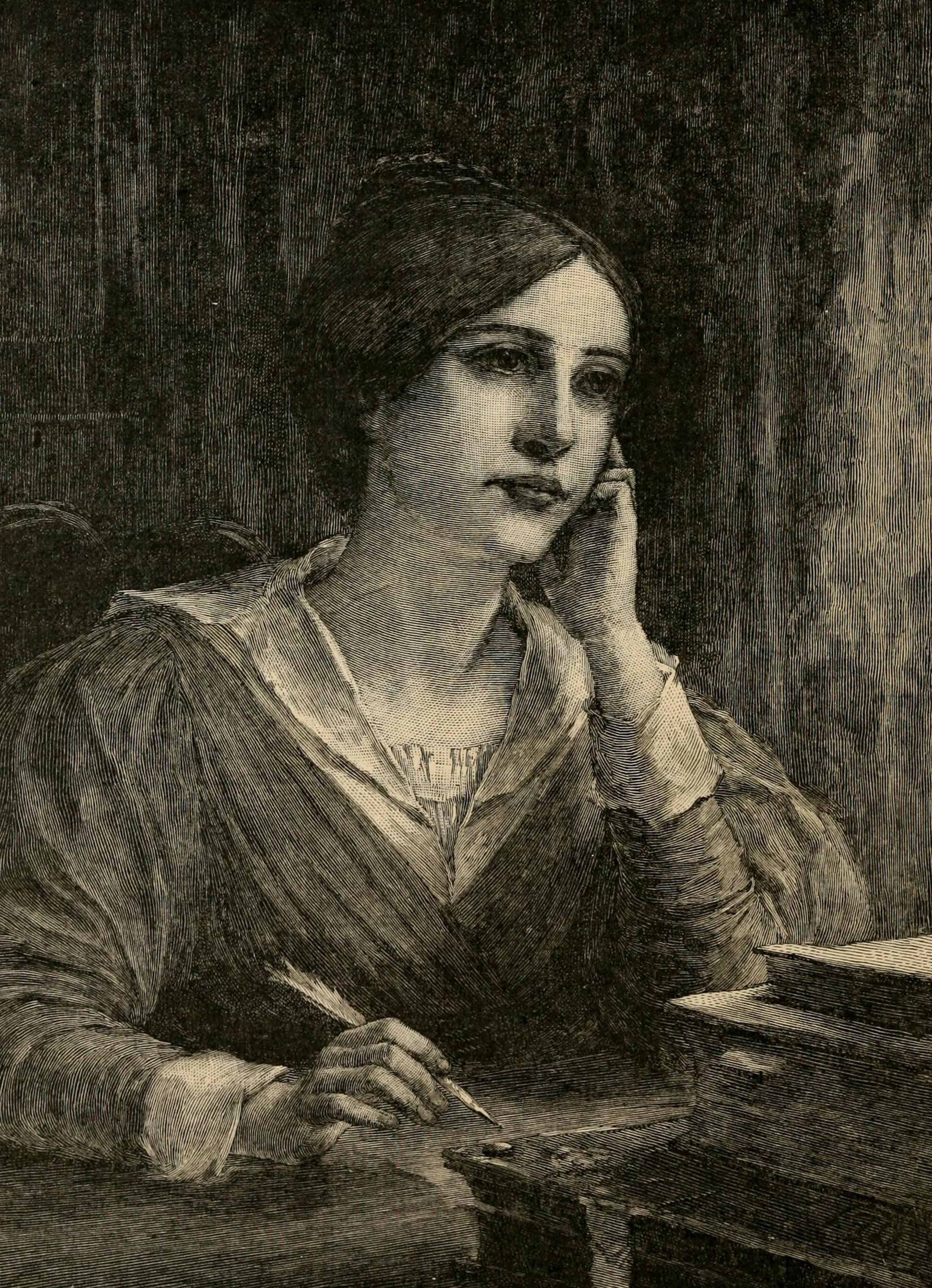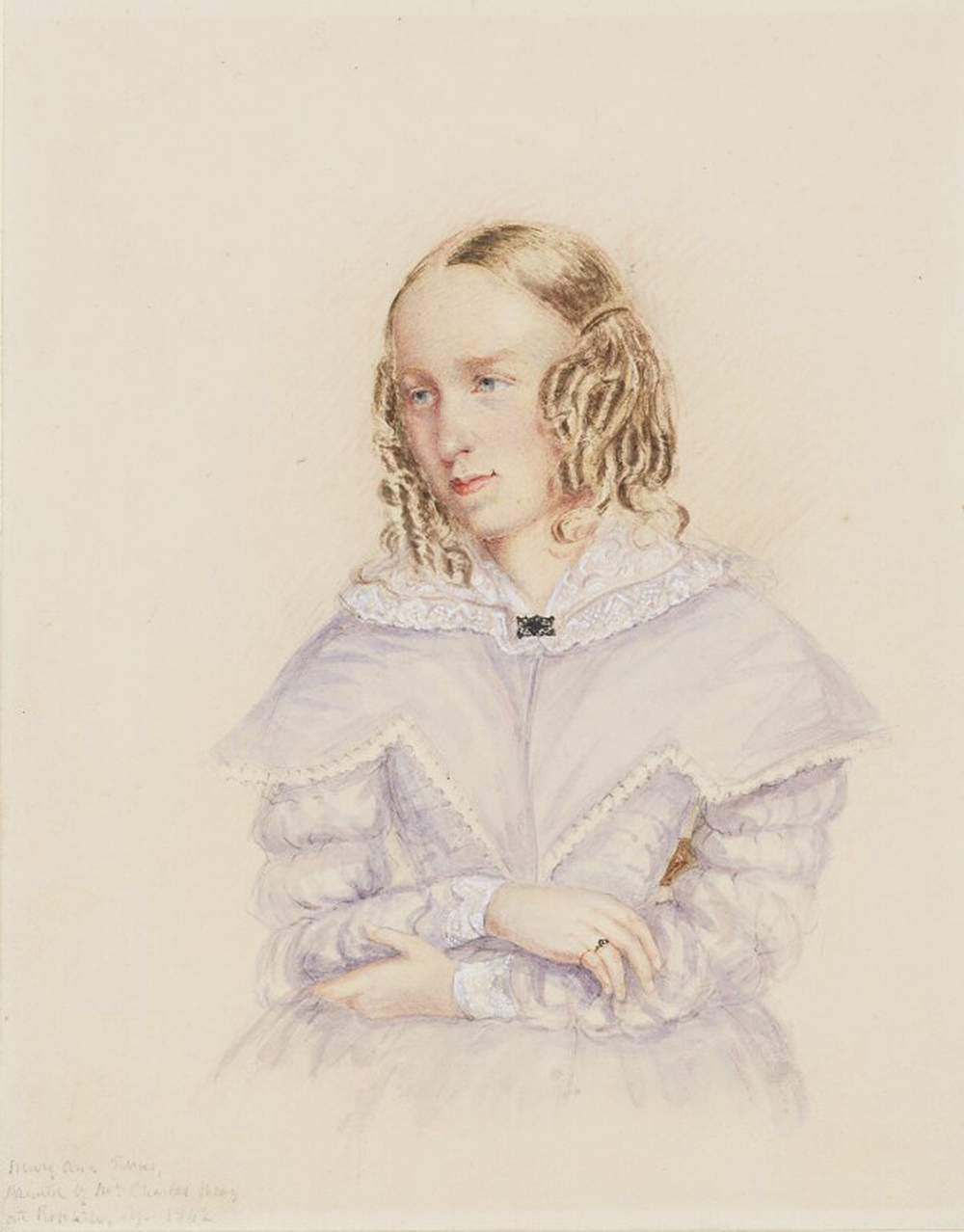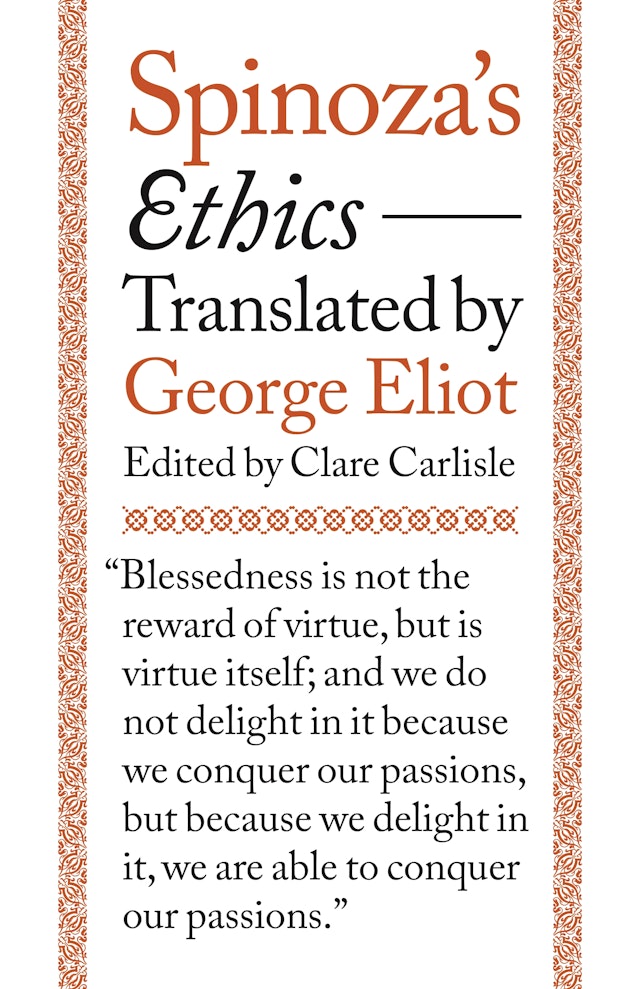
Illustration of Dorothea from an 1887 edition of Middlemarch. Flickr, Internet Archive.
Before she became George Eliot, Marian Evans spent many, many hours in the company of the philosopher Benedict de Spinoza. In December 1849, her thirtieth year, she wrote to her friend Charles Bray that “for those who read the very words Spinoza wrote there is the same sort of interest in his style as in the conversation of a person of great capacity who has led a solitary life, and who says from his own soul what all the world is saying by rote.” Here she expresses her feeling for Spinoza’s truthfulness in speaking “from his own soul,” while the word “conversation” hints at an intimacy, almost a friendship, with that philosophical soul, which she felt she gained through his writing.
Yet she wrote very little about Spinoza, or about the effect that this close encounter with his soul had upon her own. “What is wanted in English is not a translation of Spinoza’s works, but a true estimate of his life and system,” she told Bray, after abandoning her translation of Spinoza’s second masterpiece, the Theologico-Political Treatise, which she began in the spring of that year. “After one has rendered his Latin faithfully into English,” she continued, “one feels that there is another yet more difficult process of translation for the reader to effect, and that the only mode of making Spinoza accessible to a larger number is to study his books, then shut them, and give an analysis.” Despite her much more extensive acquaintance with the Ethics during the 1850s, she never attempted this task of exposition and analysis. Yet some readers have found in her novels literary “translations” of Spinozism, accomplished through character and narrative.
How did a lower-middle-class woman from a solidly Anglican Midlands family discover the Latin writings of this unconventional philosopher, so alien to any English curriculum? Indeed, the education of Mary Anne Evans—her given name, which she first changed to Mary Ann in 1836, and then to the less demure Marian when she moved to London in 1851—took her in the opposite direction from Spinozism: while at school in the 1830s she became a fervent evangelical Christian. Of course, she could not go on to study at Oxford or Cambridge, nor at London’s newly founded University College or King’s College—it was not until much later in the nineteenth century that a university education became possible for even a small number of women in England. After leaving school at sixteen, she educated herself in the library of Arbury Hall, the Warwickshire estate managed by her father, Robert Evans.
In 1841, now in her early twenties, she moved with her father to Foleshill, a couple of miles north of Coventry, where she became friends with freethinkers Charles and Cara (also known as Caroline) Bray, and Sara and Charles Hennell (Cara Bray’s sister and brother). She flourished in this intellectual circle, reading Schiller, Lessing, and Goethe with Cara, and quickly devouring recent historical studies of the Bible—some by German scholars, as well as Charles Hennell’s Inquiry Concerning the Origin of Christianity (1838)—which persuaded her that Christianity was based on “mingled truth and function.” By 1842 she had caused a deep rift with her father and brother by refusing to go to church, though after a few months she relented and attended mass again. She would retain a critical sympathy with the religion of her childhood throughout her life, but her spiritual appetites could no longer be satisfied by evangelical piety.

It was not long after this loosening of faith that Mary Ann encountered Spinoza, almost certainly for the first time. At the beginning of 1843 the Brays received a copy of one of Spinoza’s works from Robert Brabant, who was Coleridge’s doctor in 1815–16, while the declining poet was living in Wiltshire and writing his Biographia Literaria (which contains several brief references to Spinoza, largely in relation to German idealism). Mary Ann, who by this time had taught herself Latin from a textbook, translated part of this work by Spinoza. It must have been the Theologico-Political Treatise; in a letter to Sara Hennell in October 1843, Mary Ann repeated one of this book’s core arguments—“We must part with the crutches of superstition. Are we to go on cherishing superstitions out of a fear that seems inconsistent with any faith in a Supreme Being?”—and echoed Spinoza’s conviction that “we cannot fight and struggle enough for freedom of inquiry.” Sara also recorded the influence of Spinoza’s Treatise on her friend at this time: “She said she considered the Bible a revelation in a certain sense, as she considered herself a revelation of the mind of the Deity.” Mary Ann was evidently struck by Spinoza’s claim that “God’s eternal word and covenant and true religion are divinely inscribed upon the hearts of men, that is, upon the human mind.” One consequence of Spinoza’s panentheism was his critique of the Protestant view that the Bible is the privileged site of divine revelation: he suggested instead that “the Eternal Wisdom of God…has manifested itself in all things and especially in the human mind, and above all in Christ Jesus.”
Of course, human minds are not always clear manifestations of divinity; they can be very “troublesome,” as Spinoza acknowledged in the Ethics. Robert Brabant, the proximate source of Mary Ann’s enthusiasm for Spinoza, became a difficult figure for her after she visited him at his home in Devizes in November 1843. During this stay she was drawn into an intense friendship with the married, much older, and rather predatory man and was sent home early by his wife. Three years after this embarrassing episode, in 1847, she returned Brabant’s copy of the Theologico-Political Treatise, imagining herself hurling it toward Devizes so that it would leave “its mark somewhere above Dr B.’s ear.” But she was keen to get Spinoza back again. She asked Sara Hennell, who lived in Hackney, to obtain the same edition for her from London: “Mind—I really want this,” she wrote to Sara in February 1847. Mary Ann did indeed acquire a Spinoza of her own, and he would be one of her most constant companions over the next decade, during which she made the biggest leaps of her life—to London, and the editorship of a major literary journal; to a partnership with George Henry Lewes; and to the novels of George Eliot.
By the end of the 1840s, Mary Ann had already confronted Spinoza’s legacy through her translation of D.F. Strauss’ The Life of Jesus, Critically Examined. This work, published in German in 1835, was indebted to the daringly critical interpretation of the Bible offered by Spinoza in the Theologico-Political Treatise, as well as to Friedrich Schleiermacher’s scientific, historical approach to theology, itself influenced by Spinozism. Though Strauss’ Life of Jesus was an enormously important book, marking a turning point in the study of Christianity, and indeed in European thought, translating it was not a labor of love for Mary Ann. For 1,500 pages Strauss plodded through the Gospels, scrutinizing every episode in Jesus’ story for evidence of historical veracity. Mary Ann began to translate the book in 1844, while ensconced in the Brays’ freethinking circle in Coventry, and in 1846, when she had nearly finished, she told her friends she was “Strauss-sick.” Translating gave her headaches, and “it makes her ill dissecting the beautiful story of the crucifixion, and only the sight of the Christ image and picture make her endure it,” Cara Bray wrote to Sara Hennell that February. On Mary Ann’s desk in her father’s house, along with Strauss’ thick book and her ever-growing manuscript, was a small cast of Bertel Thorvaldsen’s statue of Christ, standing with arms outstretched to receive his overburdened followers. The original statue was (and still is) in the Church of Our Lady in Copenhagen, and during the mid-1840s, while the miniature version watched over Mary Ann toiling at her Life of Jesus, the larger-than-life original was welcoming Søren Kierkegaard into church on Sundays.
Mary Ann’s translation of Strauss was published anonymously in London in 1846 by John Chapman, a friend of the Brays. When she moved to London at the beginning of 1851, altering her name to Marian, she lodged at Chapman’s house on the Strand. She began to attend Francis Newman’s lectures on geometry at the newly opened Ladies College in Bedford Square, Bloomsbury—but it was probably Spinoza, not Newman, who suggested to her that living, changing human beings could be studied geometrically. She would encounter this insight in the spring of 1855, while translating Part III of the Ethics: here Spinoza begins his study of the emotions by declaring his intention to consider human feelings, actions, and appetites “as if the subject were lines, surfaces, or solids.”
Lines and planes are straightforward enough, but solid bodies are another matter—and the conjunction of human bodies in one place can evoke messy feelings, actions, and appetites. Chapman’s house on the Strand was a case in point: he lived there with his wife and mistress, and soon after Marian’s arrival she became romantically entangled with Chapman too. This domestic arrangement ended in tears—Marian’s—and a distraught train journey back to Coventry. But she remained friends with Chapman, and when he bought the Westminster Review in the summer of 1851 she agreed to edit it with him. By the end of September she was back in London, now the unofficial and anonymous editor of the city’s leading intellectual journal, and “at last in her element.” In October 1851 she met George Henry Lewes for the first time; he was married, though his relationship with his wife was unconventional, and their youngest children were fathered by Lewes’ friend Thornton Leigh Hunt. During 1852 Marian and Lewes became close friends, and by 1853 they were “more than friends.”
Marian was soon to embark on her most sustained study of Spinoza. In July 1854 Marian traveled to Weimar with Lewes, the man whose love and support became indispensable to her artistic fulfillment, professional success, and personal happiness. This journey to Germany marked the beginning of their public relationship, a de facto marriage that lasted until Lewes’ death in 1878; Marian sought recognition as his wife by asking people to call her “Mrs. Lewes.” In Weimar, these “two loving, happy human beings” explored the city together, socialized with local intellectuals, heard three Wagner operas, and enjoyed the “delightful domesticity” they had been unable to share in London. At this time Lewes was writing his biography of Goethe, and Marian worked closely with him on this project; they spent their mornings writing together, and evenings reading together. Meanwhile, back in England, news of their relationship was causing a scandal, even among their friends, for Lewes was still married, though separated from his wife. Victorian ideals of proper feminine virtue were such that Marian was judged much more harshly than Lewes for their decision to live together.
At the beginning of November, after a little more than three months in Weimar, the couple took a train to Berlin. They arrived in Berlin on November 3, 1854, and on November 8 Marian began to translate Spinoza’s Ethics—a task she probably undertook to help Lewes, who had agreed with the publisher Henry Bohn to produce an English edition of the Ethics for Bohn’s Philosophical Library.
Marian’s entry in her journal that day offers a glimpse of her new life in Germany: “Began translating Spinoza’s Ethics. Wrote to Mrs. Robert Noel to thank her for trying to get me an introduction to Humboldt. Read Wilhelm Meister aloud in the evening.” From this point in her journal, the phrases “Translated Spinoza” and “Worked at Spinoza” recur frequently; Marian evidently spent most of her mornings in Berlin translating the Ethics, though on some days she suffered from headaches that slowed or stopped her work. Nevertheless, she made rapid progress. On December 18 she recorded in her journal that she had “finished revising Part I of Spinoza’s Ethics,” and the following day she “began Part II of Ethics.”
Journal entries like these give insight into Marian’s approach to her translation. Her manuscript itself shows that her work of translation was not simply a linguistic and literary exercise of rendering Spinoza’s Latin into clear, elegant English: she was also engaging philosophically with Spinoza’s text.
Excerpted from Spinoza’s Ethics, translated by George Eliot, edited by Clare Carlisle. Copyright © 2020 by Princeton University Press. Reprinted by permission.
